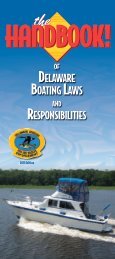Indiana Boating Handbook - Boat Ed
Indiana Boating Handbook - Boat Ed
Indiana Boating Handbook - Boat Ed
Create successful ePaper yourself
Turn your PDF publications into a flip-book with our unique Google optimized e-Paper software.
Specifically for PWCs<br />
Although a personal watercraft (PWC) is<br />
considered an inboard vessel and comes under the same<br />
rules and requirements of any other vessel, there are specific<br />
considerations for the PWC operator.<br />
steering control<br />
steering nozzle<br />
Steering and Stopping a PWC<br />
◆◆ PWCs are propelled by drawing water<br />
into a pump and then forcing it out<br />
under pressure through a steering<br />
nozzle at the back of the unit. This<br />
“jet” of pressurized water is directed<br />
by the steering control—when the<br />
steering control is turned, the steering<br />
nozzle turns in the same direction.<br />
For example, if the steering control<br />
is turned right, the nozzle turns right<br />
and the jet of water pushes the back of<br />
the vessel to the left, which causes the<br />
PWC to turn right.<br />
Remember—no power means no steering control …<br />
You must always have power in order to maintain control.<br />
If you allow the engine to return to idle or shut off during<br />
operation, you lose all steering control. The PWC will<br />
continue in the direction it was headed before the engine<br />
was shut off, no matter which way the steering control is<br />
turned.<br />
◆◆<br />
A PWC has no brakes. Always allow plenty of room for<br />
stopping. Just because you release the throttle or shut off<br />
the engine does not mean you will stop immediately.<br />
18 <strong><strong>Boat</strong>ing</strong> Basics<br />
Copyright © 2010 <strong>Boat</strong> <strong>Ed</strong>, www.boat-ed.com



